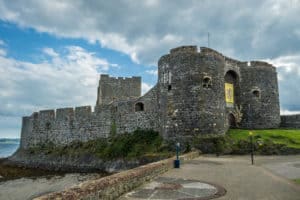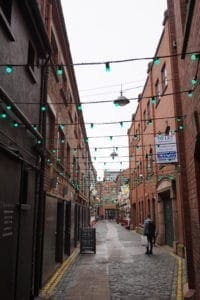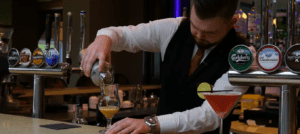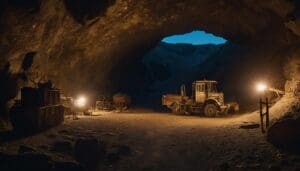Where Sea Meets Sky: Unveiling Ireland’s Rugged Coastal Myths
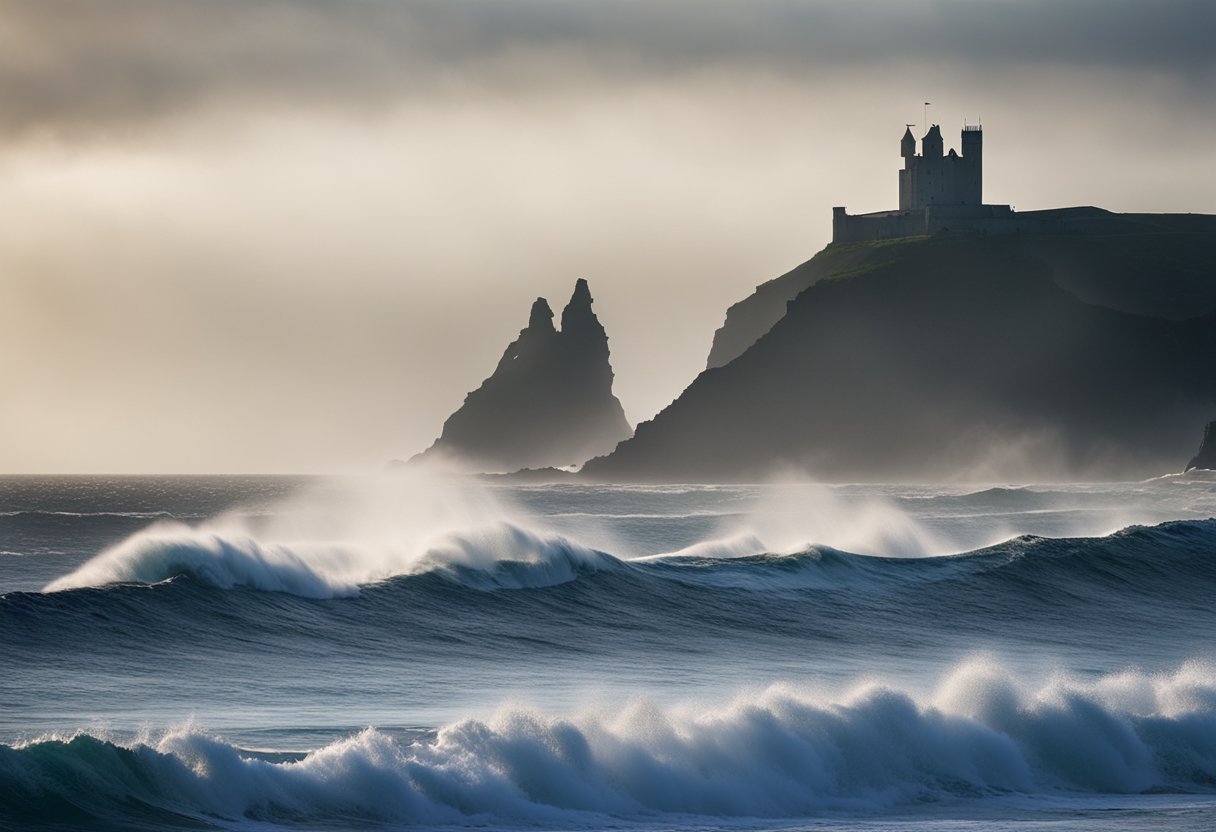
Updated On: March 24, 2024 by Eman Sameh
Ireland’s rugged coastlines are a tapestry of natural splendour and mythic tales, where the relentless Atlantic carves shape into cliffs and coves. As we journey along this wild frontier, the distinction between sea and sky often blurs, weaving a narrative as deep as the waters themselves. The interplay of elements has birthed a unique spectacle that has seen Ireland’s shores become a bastion of culture and history, shaped by waves and whispered stories alike.
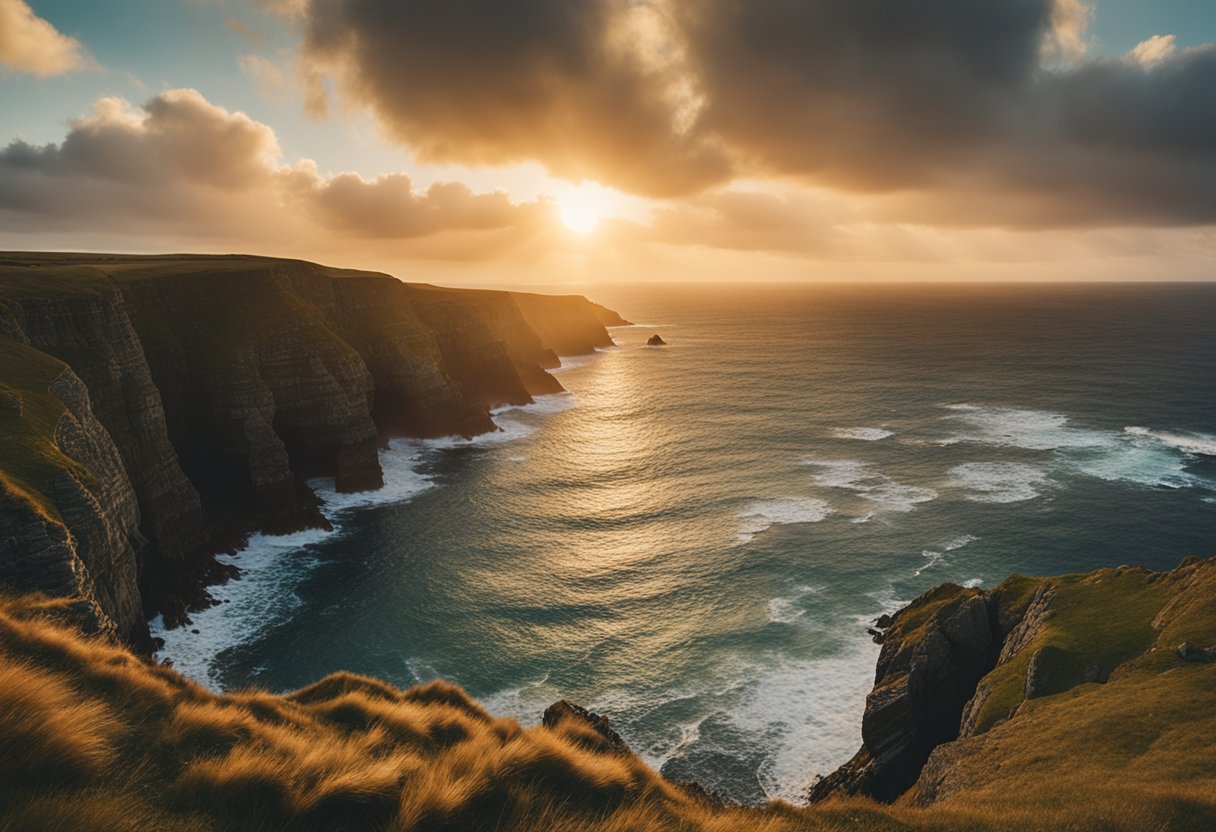
The cliffs and shores of Ireland serve not only as geographic landmarks but also as repositories of a rich maritime heritage stretching back through the ages. From the echo of historical events that played out along the water’s edge to the songs of seafaring traditions, Ireland’s coastal regions are as culturally significant as they are naturally stunning. Our coastal cities and villages, complete with their charismatic charm, stand as a testament to generations of people shaped by the sea.
In our exploration, we embrace the vibrant wildlife that thrums beneath the Irish waves, meeting the natural habitats that play host to a glistening array of marine life. We commit to conserving these enchanted environments for sustainable visitation, ensuring the fascination sparked by Ireland’s shores continues for future adventurers. The coastline’s compelling allure calls us to explore, to uncover the interwoven story of land, sea, and sky—a story where every horizon breathes with the spirit of Ireland.
Geographic Wonders of Ireland’s Rugged Coast
Ireland’s coast boasts a tapestry of stunning geological formations, each telling a unique story of Earth’s history. We’ll explore the remarkable forces that shaped its vistas, the towering headlands that guard the shore, and the breathtaking cliffs that have beckoned travellers for generations.
The Formation of the Coastlines
The coastline of Ireland is the product of millions of years of geological activity. Volcanic activity, glaciation, and the relentless power of the Atlantic Ocean have crafted a shoreline that’s as varied as it is dramatic. A fine example of this is the Giant’s Causeway, an area of about 40,000 interlocking basalt columns, the result of an ancient volcanic eruption and subsequent cooling.
Prominent Irish Headlands
Our journey along the coast reveals numerous headlands, each with its own character. The Wild Atlantic Way stretches for 1,500 miles along Ireland’s western seaboard, with headlands that rise high above the ocean, offering vantage points and challenging the power of the sea. Among these, Mizen Head in County Cork and Malin Head in County Donegal stand prominently as beacons at the southernmost and northernmost parts of the mainland, respectively.
Iconic Cliffs and Coastal Features
Among the most awe-inspiring geographical features are sea cliffs, which uniquely define the Irish coastscape. The Cliffs of Moher, soaring to over 700 feet, serve as an indelible mark of nature’s workmanship on the western coast. These cliffs offer more than a sheer drop; they are a sanctuary for seabirds and a symbol of Ireland’s natural heritage. Further, features like the Skellig Islands fuse myth with geography as they rise steeply from the ocean, beckoning visitors with their untouched allure and monastic history.
Historical Echoes Along the Shore

We’re about to explore the remnants of Ireland’s ancient past and the persistent marks left by historical fortifications along the rugged coastlines. These stony sentinels and archaeological wonders are testimonies to Ireland’s rich and turbulent history.
Ancient Neolithic Sites
Ireland’s coastline cradles some of the most significant Neolithic sites in the world. Among these, the prehistoric tombs and ceremonial landscapes are a testament to Ireland’s ancient civilisations. Archaeology here delves into the very fabric of human history, revealing a society deeply connected to celestial events. One such place is the Bru na Boinne, a complex of Neolithic mounds, stones, and henges that date back over 5,000 years—older than the pyramids of Egypt.
Historical Castles and Forts
The Irish coast stands guard to numerous castles and forts, relics of a medieval past where warfare and defence were a way of life. These structures often occupy strategic positions, overlooking cliffs and estuaries. They were a response to both the internal feuding of Irish chieftains and the external threat of invaders like the Vikings. The imposing Dunluce Castle, perched on the edge of a rugged cliff in County Antrim, is a striking example, with its history intertwined with both the Viking raids and later Norman invasions.
Our shores are adorned with such historical echoes, inviting us to marvel at the endurance of these cultural legacies and the stories they continue to tell.
Ireland’s Maritime Heritage
As an island nation, Ireland’s maritime heritage is interwoven in the very fabric of its identity. Our rugged coastlines have given life to rich fishing traditions and vibrant port towns while providing the backdrop for the legendary lighthouses that have long served as beacons for maritime navigation.
Fishing Traditions and Port Towns
Our fishing traditions date back centuries, forming the lifeblood of many coastal communities. In particular, towns like Kinsale and Cork have thrived for generations on the bountiful harvests of the Atlantic Ocean. Markets bustle with the daily catch, offering a glimpse into Ireland’s relationship with the sea.
- Kinsale: Known for its picturesque beauty and historic significance in the fishing industry.
- Cork is a vital port city with vibrant trade and cultural exchange rooted in its proximity to the water.
Legacy of Lighthouses and Maritime Navigation
The legacy of Ireland’s maritime heritage is nowhere more evident than in our historic lighthouses. These structures, from Fastnet Rock off the coast of Cork to Fanad Head in Donegal, have stood as guardians of the Irish coast, guiding vessels through the perilous waters of the Atlantic.
- Fastnet Rock: Often called ‘Ireland’s Teardrop,’ this lighthouse is the last sight of Ireland for ships bound west.
- Fanad Head: Boldly perched on the northern shores, it is a testament to Ireland’s commitment to safe passage at sea.
Our coastlines tell stories of a profound connection between people and the sea, with places like Larne and the Shannon estuary evidencing a maritime history as deep as the waters surrounding us. With each fish pulled from the sea and every light cast from our lighthouses, we honour the legacy of Ireland’s maritime heritage.
Irish Island Exploration
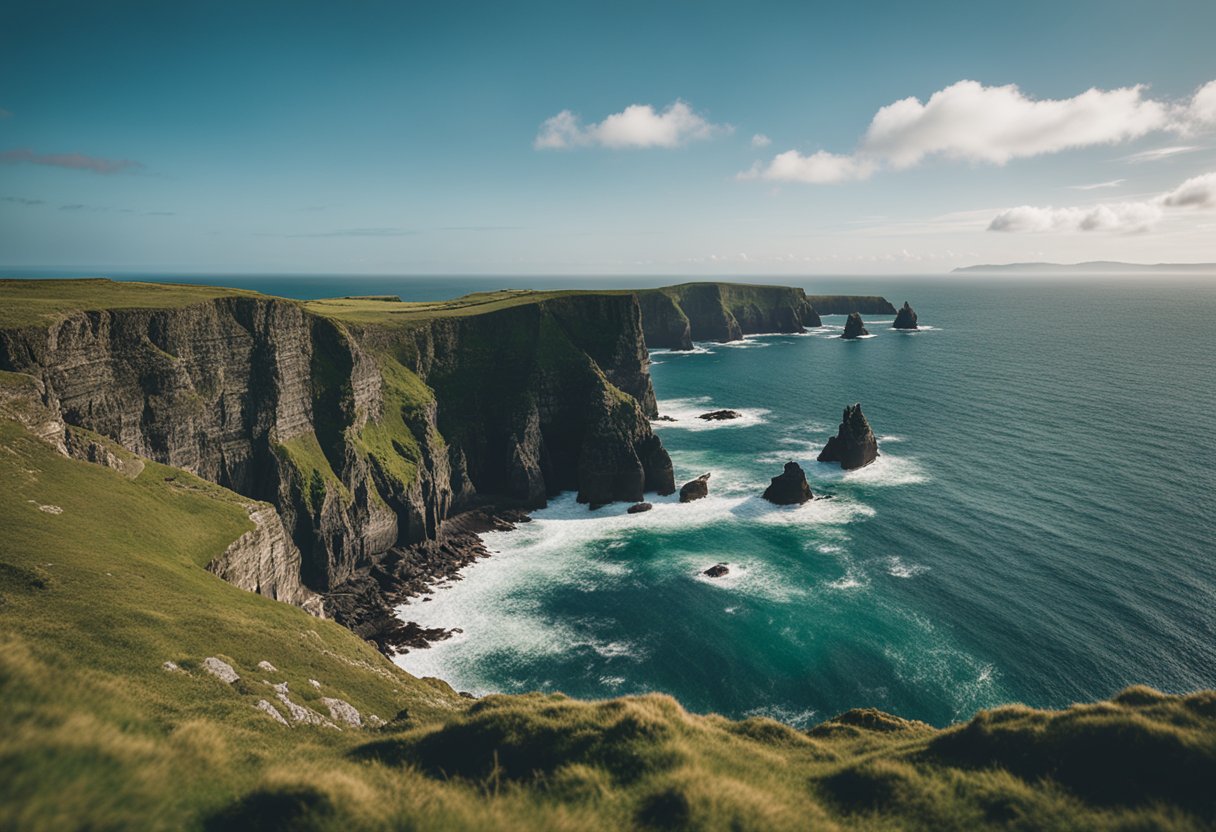
We’re venturing to the edges of Ireland, where the untamed Atlantic Ocean carves out a rugged, breathtaking landscape, home to islands steeped in history and natural beauty.
Aran Islands and Monastic Sites
The Aran Islands are a bastion of Irish culture, where Gaeilge (the Irish language) flows as freely as the surrounding waters. Here, one finds a tapestry of ancient monastic sites, like the remnants of abandoned abbeys that whisper tales of the monks who once sought spiritual solitude in this harsh yet majestic environment. For example, the ruins of the seventh-century church, Teampall Bheanáin, on Inis Mór, stand as a testament to this monastic heritage.
Exploring these hallowed sites, we’re given a rare glimpse into a past where devotion and daily life entwined against a backdrop of green pastures and ocean spray. It’s a profound experience best captured with a respectful curiosity, absorbing the serene atmosphere that has drawn pilgrims and travellers alike for centuries.
The Wild Beauty of Blasket and Achill
The Blasket Islands, off the coast of Kerry, are a wild sanctuary where nature reigns. Once inhabited, these islands now lay abandoned, but their stories are preserved in the windswept ruins and rugged terrain that define them. An excursion to these islands offers an evocative journey through a deserted village on Great Blasket, allowing us to reflect on the resilience of past communities that thrived on the edge of the world.
On Achill Island, dramatic cliffs thrust out of the sea as though challenging the power of the Atlantic itself. Here, pristine beaches like Keem Bay invite us to admire their untouched beauty. Achill offers a mix of peaceful retreat and adventurous exploration, complemented by the hospitality of its local residents, adding to the rich tapestry that makes Ireland’s islands truly enchanting.
As we traverse these islands, our connection to Irish heritage deepens, and we’re reminded of the raw power and poetic allure found where the sea meets the sky.
Wildlife and Natural Habitats
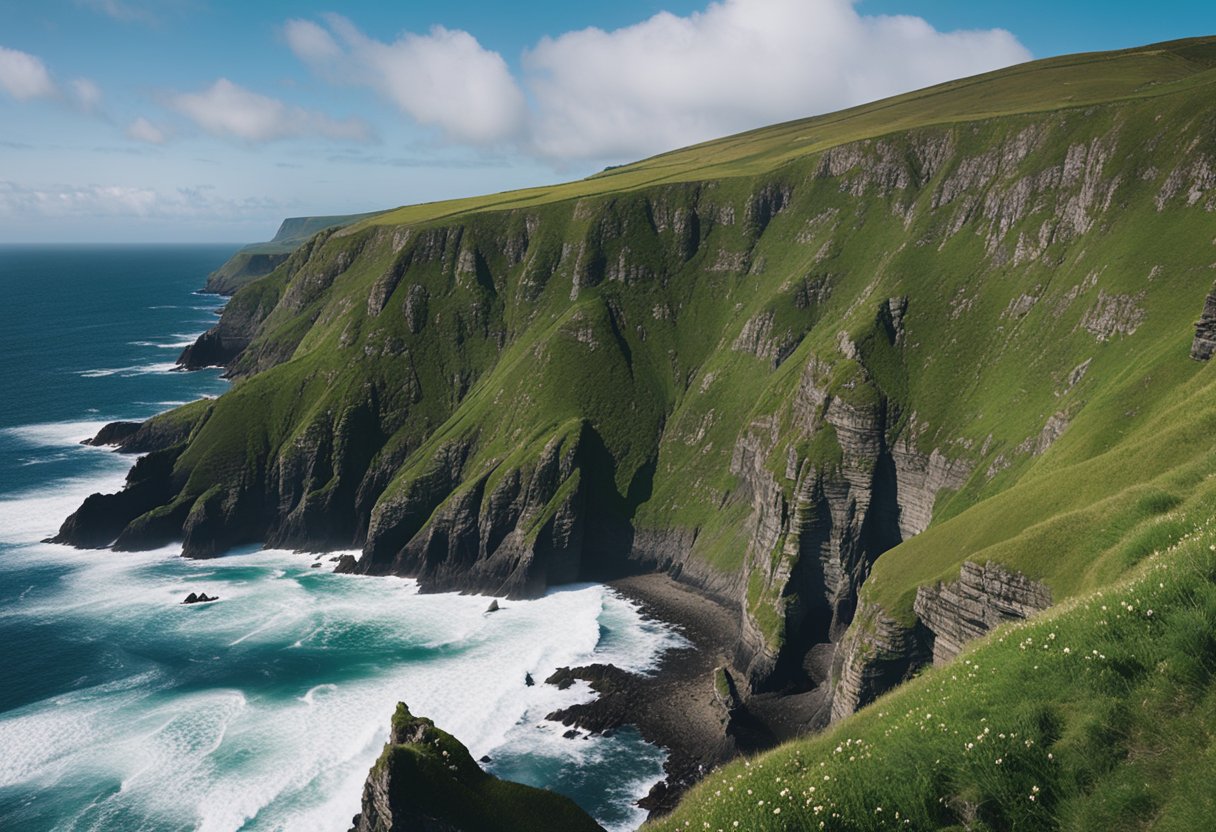
Ireland’s rugged coastlines are more than just stunning vistas; they are a cradle for an array of wildlife and natural habitats. Here, the vibrant ecosystems teem with species ranging from the smallest organisms to the most magnificent marine creatures.
Coastal Biodiversity and Marine Life
Our seas brim with life, and Ireland’s coastal waters are no exception. An assortment of dolphins, including the Bottlenose, Harbour Porpoises, Risso’s Dolphins, and Common Dolphins, thrive here. Their natural curiosity often brings them close to boats and the shore, a delightful sight for marine enthusiasts. The Irish sea also houses vast ecosystems, supporting a diverse marine life that adds to the rich tapestry of Ireland’s natural habitats.
Birdwatching and Basking Sharks
For bird enthusiasts, Ireland’s coast is a haven teeming with avian life. From seagulls to rare migratory species, the variety is extensive. In the spring and early summer, we also see magnificent basking sharks, the second-largest living shark. These gentle giants are often spotted in Irish waters, gracefully moving through the sea and occasionally breaching the surface; a truly breathtaking phenomenon for wildlife watchers.
Cultural Insights and Traditions
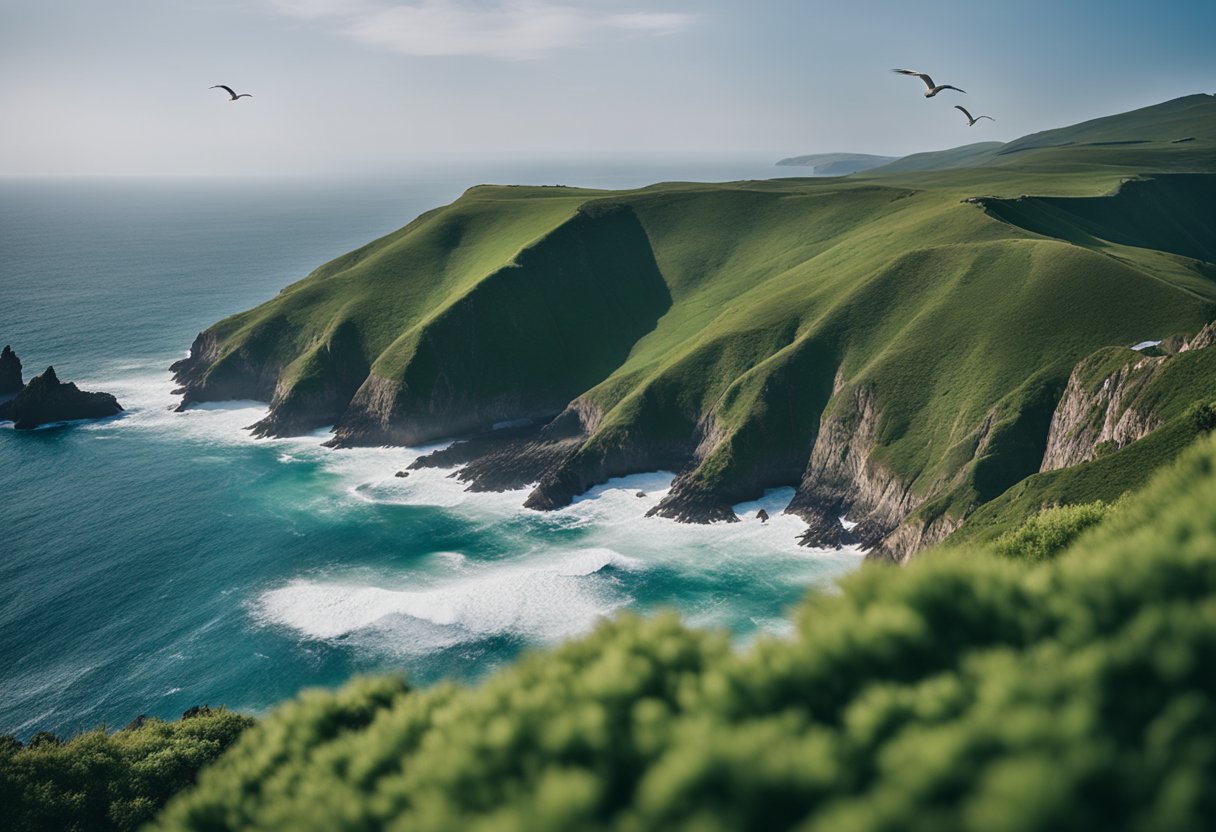
Ireland’s rugged coastlines are not just a testament to the country’s breathtaking natural beauty but also a canvas that depicts the deep cultural ties the Irish have with the sea. The coastal traditions of Ireland are a complex tapestry of folklore and practical customs passed down through generations against the backdrop of the wild Atlantic.
Irish Folklore and Coastal Mystique
The Irish coast has long been steeped in mystique and folklore, with stories passed down that are as captivating as the coastlines themselves. Among the most enchanting are the tales of the selkies; seal creatures from Irish and Scottish mythology that can shed their skins to become human. These myths, often laden with themes of love and longing, continue to fire the imagination of locals and visitors alike, forming an integral part of coastal communities’ identities. For a more in-depth look into these narratives, one might explore the ultimate mythology blog on selkies.
Seaweed Gathering and Oceanic Crafts
Going beyond mythology, the Irish coastal way of life includes a rich tradition of seaweed gathering. This practice involves locals collecting various types of seaweed for use in cuisine, medicine, and fertiliser—showcasing a sustainable relationship with the marine environment. The ocean’s bounty also extends to crafts, with materials such as driftwood and sea glass often collected to create unique, handcrafted items that embody the spirit of the ocean. These crafts not only represent a livelihood for many coastal dwellers but also contribute to the cultural fabric of the region.
Our coastlines are not merely edges where the land ends; they are the beginnings of stories, traditions, and livelihoods that merge to form the rich tapestry of Irish coastal culture.
Adventurous Activities by the Atlantic
The Atlantic Ocean offers a thrilling playground for those seeking to engage with nature. From the crash of the waves to the call of the seabirds, Ireland’s rugged coastlines are a beacon for outdoor enthusiasts.
Coastal Hiking and Mountainous Challenges
We find that hiking along Ireland’s coasts is not just a walk; it’s an immersive journey through a tapestry of maritime history and geology. Trekking from headland to headland, adventurers witness nature’s monumental sculptures — cliffs that have been shaped by the Atlantic’s relentless force. One notable spot includes Achill Island in County Mayo, where hikers can soak in panoramic views and mountainous terrain and perhaps, after a bracing walk, venture into the waters for a spot of kayaking or surfing. For those enticed by the highest sea cliffs in Europe, Slieve League in Donegal provides a memorable challenge.
Surfing and Water Sports
When it comes to surfing, the term ‘cold paradise’ fits perfectly. Our coastlines boast some of the best surf spots in the world, such as the renowned waves at Keel Beach on Achill Island. These locations cater to all levels, from beginners catching their first wave to seasoned surfers seeking the thrill of a challenging swell. Additionally, caters to water sports enthusiasts with options for kayaking amid spectacular scenery. The blend of adrenaline and serenity makes embracing these water-borne adventures an unforgettable part of any visit to Ireland’s Atlantic edge.
Unique Irish Landscapes
Ireland’s rugged coastlines are a tapestry of natural wonders, from the dramatic meeting of sea and sky to the serene beauty of its beaches and the wild charm of its hinterland.
Picturesque Beaches and Sandy Shores
We find the Atlantic coast of Ireland to be an especially striking example of natural beauty, where serene seascapes capture the quiet drama of ocean meets sky. The shores are dotted with numerous sandy beaches, each offering a unique blend of tranquillity and majestic views. For those who revel in the delight of sun-kissed sands, you can experience empty beaches that stretch invitingly, perhaps providing the perfect setting for a reflective walk or quiet contemplation.
From Peat Bogs to Lush Valleys
Our island’s landscapes are generously sprinkled with peat bogs and lush valleys, each teeming with diverse ecosystems. The bogs, with their rich peat layers, are an intrinsic part of our cultural heritage, while the valleys boast fertile lands cradled by gentle slopes, often leading to panoramic mountain views. Ireland’s karst landscapes, found particularly in The Burren, offer a stark contrast with their limestone pavements and rare flora, cascading down to meet the vibrant valleys below.
The Charm of Coastal Cities and Villages
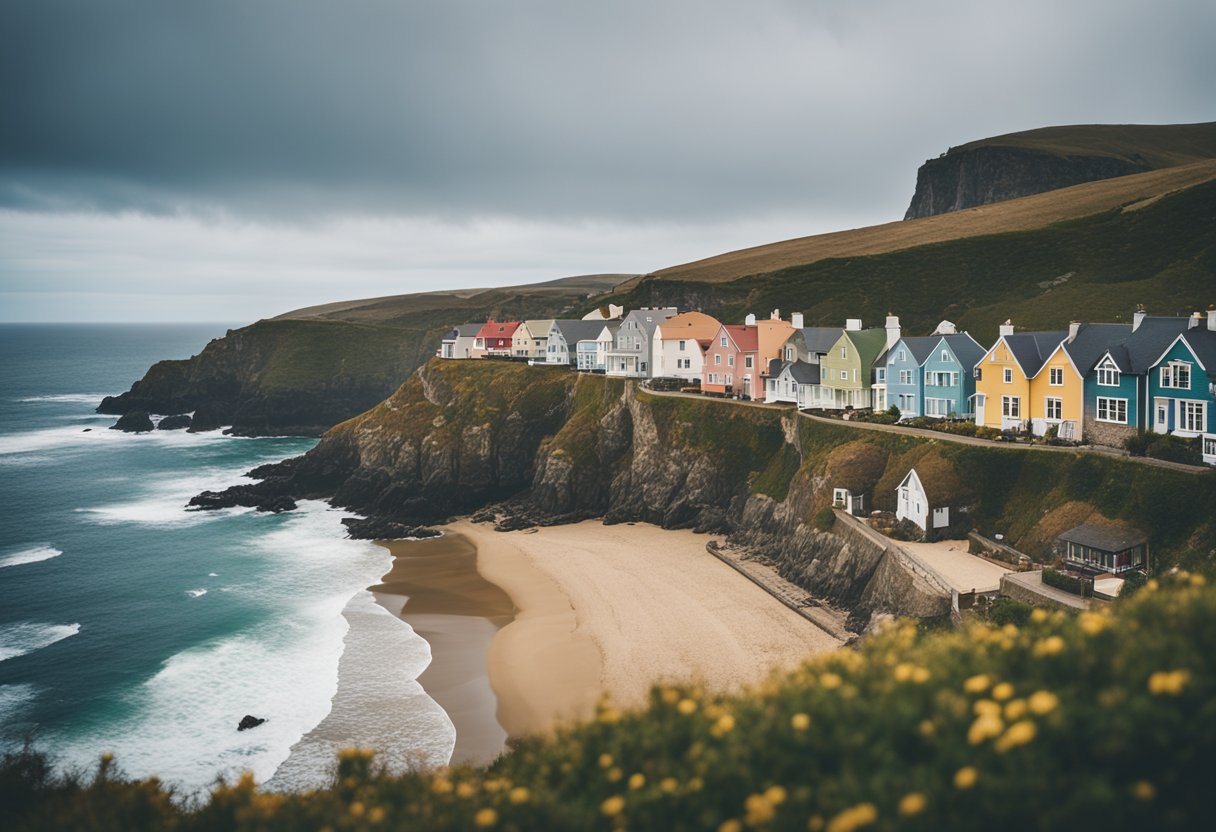
We find ourselves captivated by the allure of Ireland’s coast, where the sea meets the rugged shores and where each town and village emanates its own unique charm. The architecture of harbour cities and quaint coastal villages not only reflects Ireland’s rich history but also anchors the culture deeply to maritime life.
Dingle: A Hub of Maritime Culture
Dingle, perched on the stunning Dingle Peninsula, is a quintessence of maritime culture. Framed by rolling green hills and the wild Atlantic, it’s a locale where travellers can immerse themselves in a sensory-rich experience, from the sound of Irish spoken fluently in the streets to the sight of boats bobbing in the harbour. Here, the architecture has a colourful vibrancy, and traditional Irish music spills from the pubs, truly a cultural feast for anyone visiting.
The Splendour of Sligo and Waterford
Moving northward, Sligo sits along the Wild Atlantic Way, exuding an austere beauty that inspired the poet W.B. Yeats. The city is a harmonious blend of contemporary life with ancient roots, inviting visitors to explore both its modern amenities and prehistoric sites.
Contrastingly, Waterford, Ireland’s oldest city, is rich in Viking history. The city’s architecture is a testament to its age, with the impressive Reginald’s Tower standing as a centrepiece. Those wandering through Waterford will encounter a mix of narrow streets and spacious plazas, each corner revealing layers of history that have, over centuries, shaped its character.
Navigating Ireland’s Coast
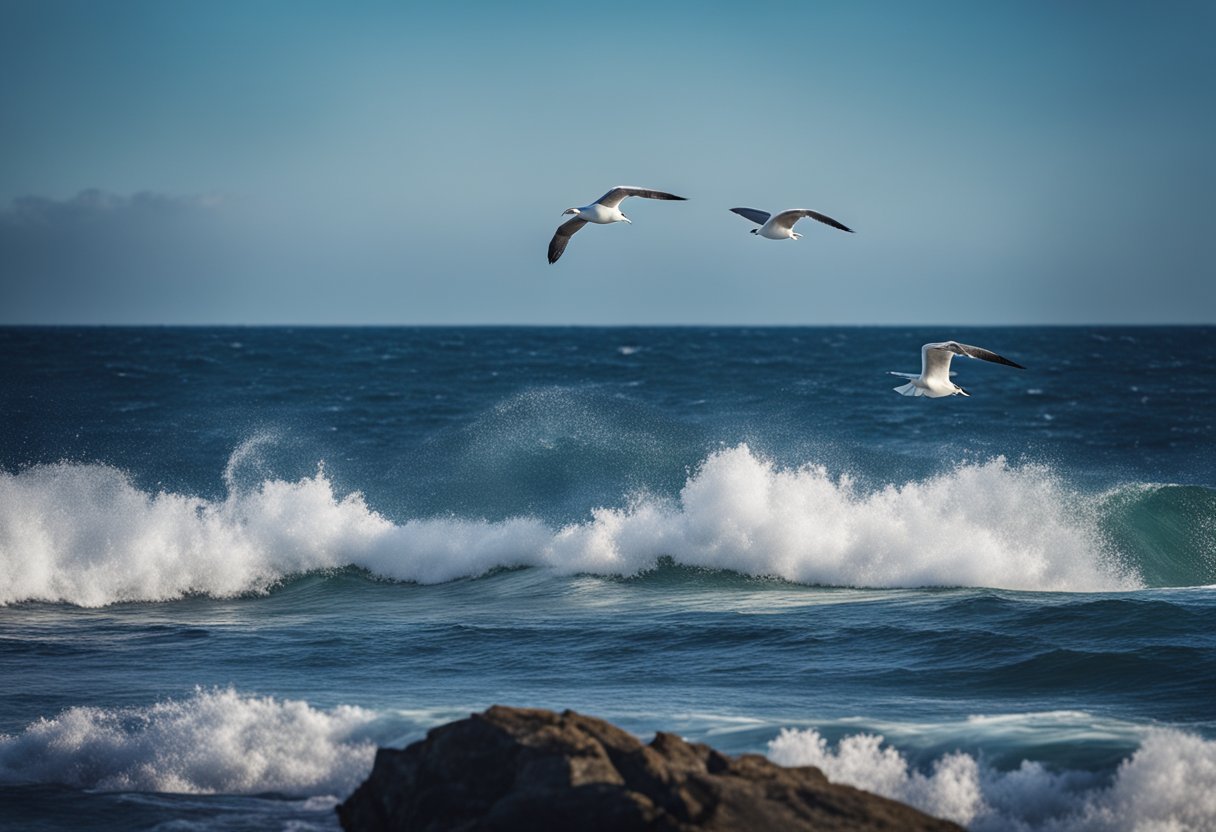
Ireland’s coastline is a treasure trove of dramatic scenery, rich history, and cultural significance, offering marvellous experiences for travellers. We will guide you through the necessary infrastructure and travel tips, as well as must-visit destinations and suggested itineraries.
Tourism Infrastructure and Travel Tips
Transportation: Accessing Ireland’s coast is convenient thanks to a robust network of roads and local transport options. We recommend hiring a car for the most flexibility to stop at the numerous viewpoints along the coast, though many areas are also accessible by bus or coach tours.
Accommodations: A range of accommodations can be found near the coast, from luxury hotels to quaint B&Bs. Booking in advance is advisable during peak travel seasons.
Safety and Navigation: Always check local weather conditions before setting off to explore the coastline, and be aware that cliff edges can be dangerous.
Support for Travellers: Tourist information centres and dedicated travel apps offer valuable support, providing maps, tide schedules, and expert advice to ensure safe and enjoyable travels.
Destinations and Itineraries
The Wild Atlantic Way: Stretching over 2,500 km along the west coast, this is Ireland’s longest-defined coastal touring route. For an unforgettable journey, begin in Donegal, marvel at the tallest sea cliffs in the country, and make your way down to the charming streets of Kinsale.
Shorter Trips: If time is limited, consider a trip from Mayo to Kinsale, where you can indulge in the rich maritime history and view the raw beauty of the western shores.
Cultural Experiences: Including local festivals, heritage towns, and the Gaeltacht regions in your itinerary will allow you to embrace the Irish culture intimately.
By considering these travel tips and destinations, your journey along Ireland’s coast is sure to be filled with magnificent landscapes, cultural encounters, and memories to last a lifetime.
Conservation and Sustainable Visitation

As we explore Ireland’s rugged coastlines, we must focus on conservation and sustainable visitation to preserve these natural wonders for future generations whilst ensuring that travellers can continue to marvel at the region’s beauty.
Protecting Natural Wonders for Future Generations
Conservation efforts in Ireland’s coastal regions are pivotal. Our coastlines are home to a rich array of wildlife and natural beauty, necessitating ongoing protection. Initiatives such as restricting access to sensitive habitats and promoting the growth of native vegetation help to maintain the ecological balance. This delicate approach ensures that these natural wonders continue to thrive.
Supporting Responsible Tourism
Sustainable tourism is equally important. We encourage visitors to be mindful of their impact and urge them to follow guidelines that support eco-friendly travel. Measures include using designated paths, supporting local businesses, and participating in education programmes about the local environment. Such practices allow travellers to enjoy the beauty of Ireland’s coastlines responsibly, ensuring that these regions retain their charm for future visitors.
By weaving conservation actions with sustainable visitation principles, we maintain the allure of Ireland’s coastlines, not just for us but as a legacy for those who follow.
Frequently Asked Questions
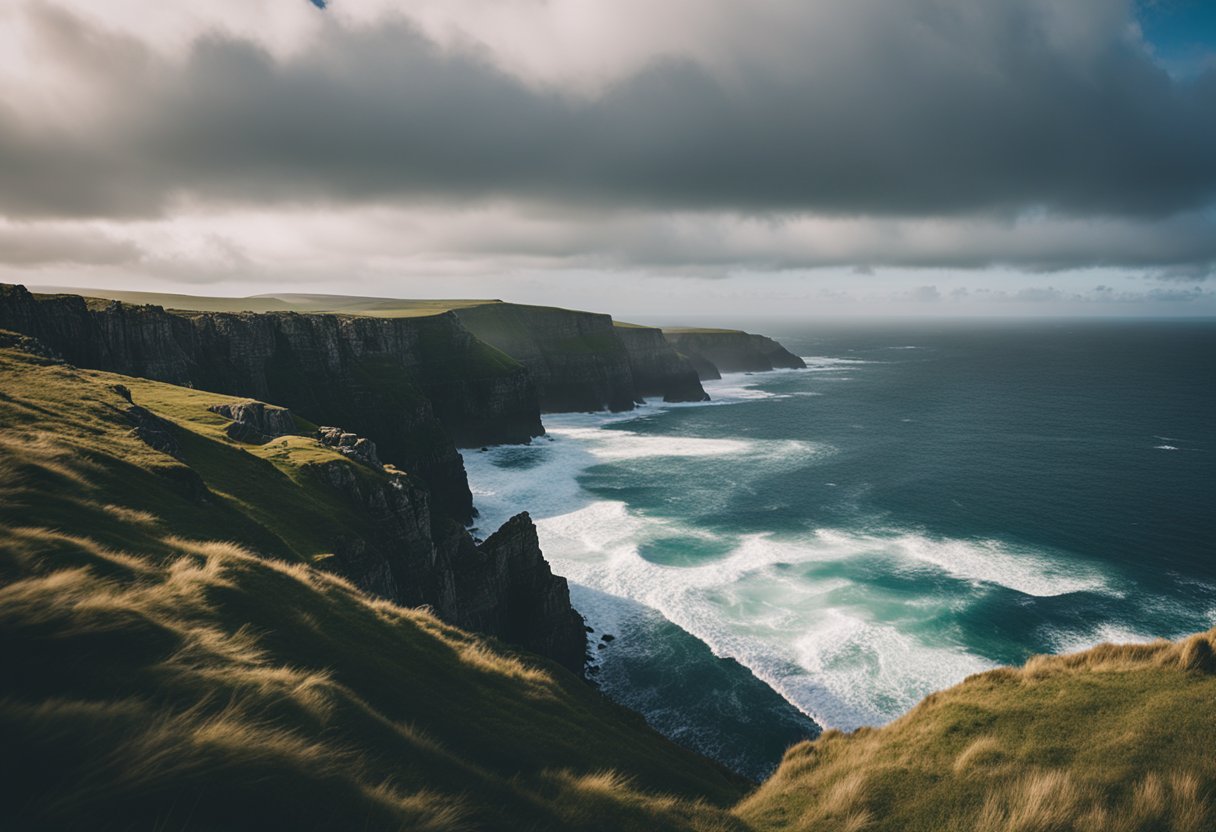
Before diving into your queries, let’s address the vibrant narratives and physical splendour of Ireland’s coastlines; from myth-enriched locales to nature’s masterpieces, these shores shape the island’s very essence.
What are some notable legends associated with Ireland’s coastal landscapes?
Ireland’s coastal landscapes are steeped in tales of mystical creatures and epic sagas. For instance, the legend of the Selkies, seal people who can shed their skins to become human, is a poignant part of our coastal folklore.
How have Ireland’s coastal regions influenced Irish folklore and mythology?
Our rugged coastlines have been a font of inspiration for countless stories, with the volatile sea reflecting the tumultuous events of our myths. The coastline serves as a setting for many of our tales, influencing stories of ancient mariners and otherworldly beings.
Can you list prominent geographical features found along the Irish coastline?
Certainly, our coastline boasts an array of geographical marvels, from the dramatic Cliffs of Moher to the unique hexagonal columns of the Giant’s Causeway. Other features include tranquil bays, rugged peninsulas, and seascapes where the ocean meets the sky.
What role has the Irish coast played in the country’s history and cultural development?
Our coast has been the edge of our world and the beginning of others. It has witnessed invasions and emigrations and has been the lifeline for coastal communities through fishing and trade, thus playing a pivotal role in our economic and social development.
How does the natural environment of Ireland’s coasts shape local traditions and practices?
The coastal environment directly influences local traditions, such as fishing methods, boat-building, and even celebrating seasonal festivals that mark the ebb and flow of coastal life.
Which literary works have been inspired by the scenery of Ireland’s rugged coastlines?
Ireland’s coastlines have inspired various literary works, from the early poetry of W.B. Yeats to more contemporary writings. Such works often depict the awe and reverence for the untamed beauty of our coastal landscapes.


